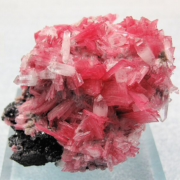Rhodonite: Properties, Use and Virtues
Rhodonite: The short version for people in a hurry!
Rhodonite, a pink-hued gemstone, is a manganese silicate that forms in specific geological environments, often associated with metamorphic rocks rich in manganiferous minerals. Its origins lie mainly in regions of the world such as Australia, Russia, the United States and Sweden.
Renowned for its metaphysical properties promoting unconditional love and emotional balance, rhodonite’s color palette ranges from pink to opaque reddish, sometimes with vein-like shades of black or brown. Its hardness generally varies between 5.5 and 6 on the Mohs scale, making it suitable for jewelry-making, although its relative fragility means it must be handled with care.
Transparent rhodonite crystals do exist, but they are very rare and, like their opaque version, pose numerous problems when cutting them, due to their propensity to split along certain axes.

Rhodonite: Table of contents
- Rhodonite: The short version for people in a hurry!
- Geological formation of Rhodonite
- Rhodonite Brute – Natural Radiance Revealed
- Sources – The Worldwide Presence of Rhodonite
- Historical significance of Rhodonite – A Mystical Heritage
- Metaphysical properties of Rhodonite – Energy of Serenity
- Rhodonite varieties
- Rhodonite colors
- Rhodonite’s durability and portability
- Rhodonite enhancements – Preserving its natural splendor
- Rhodonite Synthetic – Natural Inspiration in the Laboratory
- Rhodonite imitations – Distinguishing the genuine article
- Rhodonite care – Preserving its natural beauty
Geological formation of Rhodonite
Rhodonite forms in specific geological environments, often associated with metamorphic rocks rich in manganiferous minerals. Under the influence of heat and pressure, these minerals undergo transformations that lead to the formation of rhodonite.
Rhodonite Brute – Natural Radiance Revealed
Crude rhodonite specimens often come in massive form (no specific shape, composed of multitudes of tiny crystals) and in rare cases as prismatic crystals. The solid form will be translucent to opaque, while the crystalline form may be transparent.
Sources – The Worldwide Presence of Rhodonite
Rhodonite is found in many parts of the world, with notable deposits in Australia, Russia and the USA, as well as in England, Sweden, Japan, Brazil and the USA. for the solid form.
Australia and Japan are the main localities for transparent gem-quality rhodonite. Each source offers unique variations in color and quality.
Historical significance of Rhodonite – A Mystical Heritage
Rhodonite’s historical significance dates back many centuries and is associated with various cultures and civilizations around the world. Although specific evidence of rhodonite’s historical use may be limited, archaeological and historical evidence suggests its importance in a variety of contexts.
In ancient Greece, for example, rhodonite was sometimes used to create sculptures and decorations, due to its beautiful pink color and relative availability in certain regions. Archaeological discoveries of pink stone figurines and handicrafts have been found at sites dating back to classical antiquity, testifying to the potential use of rhodonite at that time.
In Russia, rhodonite is of particular historical importance due to its abundant presence in the Ural region. In the 18th century, rhodonite deposits were discovered in this region, leading to increased interest in this gem. Rhodonite became an essential element of Russian craftsmanship, particularly in the creation of jewelry, sculptures and decorative objects. Historic rhodonite objects can be seen in renowned Russian museums such as the Hermitage Museum in St. Petersburg.
In China, rhodonite was also used in arts and crafts, where it was appreciated for its beauty and possible spiritual properties. Rhodonite sculptures from various periods of Chinese history can be found in museum collections across the country, offering a glimpse of its cultural and historical significance.
In the modern world, rhodonite continues to be appreciated for its aesthetic and metaphysical qualities. The state of Massachusetts has even made it its official stone. Contemporary jewelry and handicrafts continue to be created from this precious stone, perpetuating its tradition.
Metaphysical properties of Rhodonite – Energy of Serenity
On a metaphysical level, rhodonite is often associated with emotional healing and compassion. It is reputed to help open the heart and clear emotional blockages, enabling wearers to align themselves with their deepest emotions.
Rhodonite varieties
Fowlerite is a rhodonite variety with zinc and a paler pink color.
Rhodonite colors
Rhodonite’s color palette consists mainly of pinkish to reddish hues, sometimes embellished with shades of black or brown in veins, depending on its chemical composition and geological history.
Transparent crystals can turn a deep red.
Rhodonite’s durability and portability
Rhodonite has a hardness that generally ranges between 5.5 and 6 on the Mohs scale, making it relatively suitable for jewelry-making. However, because of its relative fragility due to its perfect cleavage (its propensity to split in two along axes predefined by its nature), it is advisable to handle rhodonite pieces with care to avoid damage, and to favor rounded shapes such as cabochons and carvings, as well as closed settings that will best protect the stone.
Rhodonite enhancements – Preserving its natural splendor
Rhodonite is rarely processed, as it is quite affordable and common. Some specimens may be dyed or oiled to enhance their appearance.
Rhodonite Synthetic – Natural Inspiration in the Laboratory
Synthetic rhodonite is not commonly produced for commercial purposes and is therefore not widely available on the market. Most of the “synthetic rhodonite” I saw on the market looked more like imitations than laboratory-created rhodonite.
Rhodonite imitations – Distinguishing the genuine article
Rhodonite can be imitated by materials such as colored resins or gems such as rhodochrosite, which resembles rhodonite but has a white ribbon lace pattern that rhodonite does not have.
Rhodonite care – Preserving its natural beauty
To preserve the natural beauty of rhodonite, it should be cleaned with care using lukewarm water and mild soap, avoiding harsh chemicals that could damage its delicate surface. It is also advisable to store jewelry containing rhodonite separately from other pieces to avoid scratches and damage.



Leave a Reply
Want to join the discussion?Feel free to contribute!